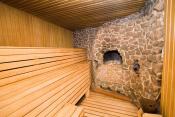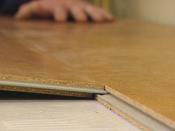Search
Login
Recommended
Choose a wallpaper for painting and paint them
Wallpaper for painting is the best option for those people who want to make quick and easy repairs without spending too much money and effort.
Content
- What wallpaper can be painted video
- Wallpaper for painting - additional sound insulation, thermal insulation and easy restoration of walls
- Types of wallpaper for painting
- Rules for sticker wallpaper for painting
- How can I paint the wallpaper video
What wallpaper can be painted
You can not paint any wallpaper, but only specially designed for painting, as these wallpapers have special qualities.
On the construction market, such wallpapers appeared about 10 years ago and quickly gained popularity.
Wallpaper for painting can give the wall a certain texture and can be repainted, if desired, annually.
Wallpaper, in their production, have a special treatment and are waterproof, while they are able to hold pigment well.
The water-based paints are used, they are able to dry quickly, are non-toxic and are capable of breathing after painting.
After painting, the joints between the paintings are almost invisible, and the width of the wallpaper for painting is 1.06 meters - this width, already in a priori, provides a smaller number of joints.
The color scheme of such wallpapers is mainly white or shades of light warm tones.
After pasting, if you like the clothes of your walls, you may not paint the first year.
And only after a while, if you want to update the interior, you can paint them.
Wallpaper for painting, usually have a pronounced texture.
You can get walls with imitation of the texture of stone, fabric, various decorative plasters.
After coloring, the texture of these wallpapers becomes even more beautiful.
Wallpaper for painting - additional sound insulation, thermal insulation and easy restoration of walls
In addition to a beautiful texture, wallpaper for painting has many positive aspects and is suitable not only for perfectly smooth walls.
Such wallpapers well mask various defects, if the defects are significant, it is better to use thicker and embossed wallpapers.
In addition, thick and embossed wallpapers can serve as additional noise insulation, as they have a high ability to absorb sounds and very well retain heat.
Painted wallpapers can be easily restored, because, at any time, you can simply paint dirty spots, scuffs or children's drawings.
Types of wallpaper for painting
Depending on the source material, production technology, wallpaper can be much different from each other. Currently, there are several types of wallpaper for painting. We will consider - paper, non-woven and glass. Common to these wallpapers is only the possibility of repainting them many times.
paper wallpaper for painting: pros and cons
The simplest wallpaper for painting are paper wallpapers.
But this is not ordinary paper wallpaper, but rather dense, saturated with water-repellent and consists of two layers.
Between these two layers of paper is a filler in the form of wood chips and sawdust.
The filler gives the paper wallpaper a beautiful embossed surface.
But, in addition to filler, to create a embossed surface, a method of producing paper wallpaper using embossing is used.
The production technology is as follows: first two layers of paper are glued together, then they are passed between special rollers, on which a special pattern is applied.
A convex pattern is applied on one roller, and a recessed shape on another roller.
Such a process of applying a picture to a roller allows squeezing it on a paper-based wallpaper.
In addition to embossed and embossed wallpapers, there are smooth paper wallpapers - such wallpapers also have two layers, but their surface is snow-white and even.
Paper wallpapers have drawbacks: they have low strength, and therefore, with inept and careless handling, they can tear, stretch or sag during operation.
You can paint such wallpaper no more than 5-7 times. The advantages include: environmental friendliness, with skillful work they look very impressive and are very cheap.
non-woven wallpaper for painting: pros and cons
Non-woven wallpapers are of good quality and average cost.
The work has established itself as a durable wallpaper, as it is a nonwoven material made from cellulose and textile fibers, and the polymer binds these fibers.
To work with such wallpaper is simple and quick, since they do not deform, do not stretch when wet, and do not sit down after drying.
The practicality of non-woven wallpapers, confirmed in practice, their use in new homes.
New houses shrink over several years, small cracks appear on the walls, if the walls are pasted with non-woven wallpaper - these wallpapers will not tear, in addition, they are able to keep small cracks from further spreading.
The disadvantages include the case when non-woven wallpaper have a vinyl spraying to simulate various textures.
But vinyl is a synthetic material, so it prevents the walls from breathing and it is undesirable to use such wallpapers in the bedroom and children's room.
cullets for painting: pros and cons
Glass thread is smelted from dolomite, lime, quartz sand and soda.
On the basis of a glass thread produce glass.
Such cullets have special strength, average service life, about 30 years.
Cullets are often made in relief, under the matting, herringbone.
Cullets are washable and can be washed by various means.
Such wallpapers include all the advantages, and the disadvantage is only their high cost.
Rules for sticker wallpaper for painting
For wallpaper to be painted, you need to choose glue.
On the packaging (roll) of wallpaper, manufacturers provide information on what type of glue can provide good adhesion to the wall.
Highly difficult to stick paper wallpaper.
Since paper wallpapers can get wet, stretch out and tear, it is important to properly spread the glue, too thin glue is not allowed.
After applying glue, the wallpaper should be soaked for no more than 10 minutes.
Non-woven and glued glass much simpler, since the glue is applied directly to the wall.
After finishing the wallpapering, the wallpaper is allowed to dry for a day, and then proceed to painting.
How can I paint the wallpaper
Wallpaper is painted with water-based paints.
Experts do not recommend buying all the necessary amount of paint at once.
First, buy the smallest packing for the sample, color a small piece of wallpaper and see the result, if you like the color, you can buy the right amount of paint.
Paint is applied to the wallpaper using a medium-sized roller.
In order not to clog the texture of the wallpaper and not reduce the number of stains - use a not very thick paint.
When staining the wallpaper for the first time, two layers of paint are applied, the second layer is applied after the first has dried, not less than 12 hours later.
In the future, with the next staining, a single coat of paint is sufficient.





